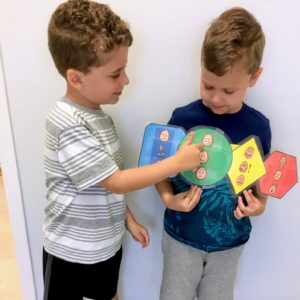Learning how to manage big feelings is an important task of childhood. In order to learn, focus, listen, communicate, and engage with peers, we need to know how to regulate emotions like stress, anger, or even excitement. It’s a tough lesson for all kids, but for those with developmental challenges it can be especially hard.
Throughout the summer at our Engines at Play camp, we used concepts from the Zones of Regulation® (The Zones) curriculum to teach our campers this invaluable skill.
How Does It Work?
Using The Zones involves 3 steps:
Recognize and Label
The first step is recognizing and labeling how you feel. A large part of this is learning vocabulary to describe feelings.
Identify the Zone
Next, you identify which of the following 4 zones you’re in based on how you’re feeling:
- Blue Zone — This is a state of low alertness and down feelings. Blue Zone feelings include tired, sad, sick, or bored.
- Green Zone — This is a state of calm alertness and you may feel relaxed, happy, focused, or content. This is the zone where optimal learning occurs.
- Yellow Zone — This is a state of heightened alertness and elevated emotions, but you still have some control. Yellow Zone feelings include stress, frustration, anxiety, excitement, silliness, the wiggles, or nervousness.
- Red Zone — This is a state of extremely heightened alertness and intense emotions, and you have very little, if any, control. You may experience elation, anger, rage, explosive behavior, devastation or terror.
Get to Green
The final step is using adaptive strategies to move through the zones and get to green. If you’re tired, for instance, you can stretch, which energizes you. Or if you’re in a rage, you can take a break and few deep breaths.
There’s No Such Thing as a “Bad Zone”
A key message for kids learning The Zones is that experiencing big emotions is not only okay, but a normal part of life. It’s not about preventing feelings, it’s about learning to manage them so they don’t negatively affect our behavior and ability to learn and relate to others.
It’s About Others, Too
Getting ourselves to green isn’t just about being calm, it’s also about navigating social interaction. We need to understand how being in the different zones impacts others, and how that can shift interpersonal or group dynamics. We also need to learn how to read others’ non-verbal cues (like facial expressions and body language) to identify how they’re feeling and how we can adjust our behavior in response.
Why We Love It
Here are some of reasons we sing The Zones’ praises:
- It works! We saw steady progress throughout the summer in our campers’ ability to regulate their emotional state. Parents saw changes at home, too.
- It gives kids a sense of self-control. Teaching kids strategies for self-regulation is like giving them a shiny toolbox to fill with tools they know how to use in different situations.
- It’s kid-friendly. The Zones was designed by a pediatric occupational therapist (Leah Kuypers), and involves simple, straightforward concepts and graphics.
How We Use It
Here are some of the ways we adapt these concepts for our kiddos:
- We create our own visual supports appropriate for 2-6 year olds.
- We make mini versions of the visual supports for the children to use at home.
- We develop unique activities tailored to the specific needs of the children.
- We emphasize the role of emotional regulation in social communication by teaching the children to look at and listen to peers in order to interpret how they’re feeling and what zone they’re in.
- We use video clips and act out scenarios to practice these skills.
If you want to learn more about The Zones and how we incorporate the method into our programs, please get in touch!


Recent Comments